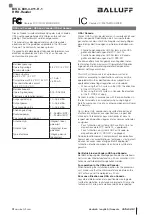
10. Advanced operation
10. ADVANCED OPERATION
Overview
•
•
About this chapter
This chapter describes the basic geometry adjustment for a single channel setup, that is used to align the image to the screen if this
is not fully achievable by mechanical positioning and lens shift and zoom. Mainly keystone correction and basic geometry correction
for single curved screens are explained in this section. Read the Geometry section in the
Expert
chapter for more details about
geometry correction.
Also Dynacolor sets are described in detail: which sets are used depending on the device parameters and options.
10.1 Geometry adjustment
Geometry adjustment
The process of digitally manipulating the position of each pixel of the source image to a different position in the pro-
jected image.
About this section
Geometry adjustments make this device more
fl
exible to be used in wide variety of curved and
fl
at-screen applications, ranging from
fl
at or straightforward cylindrical displays to the wildest shapes that can be imagined. By pre-distorting the image inside the device,
a correct geometry can be achieved on curved screens without requiring additional computational power on the image generator.
This section explains the geometry adjustment principle and lists the procedures to perform geometry adjustment: this enables us
to correct vertical and horizontal keystone, to create bows to meet the shape of cylindrical and spherical screens and to align the
channels onto each other in a multiple channel display setup. It is at all times possible to reset geometry mode by mode (starting
from the lowest mode, being 33 x 33).
10.1.1 Geometry adjustment principle
Description
Geometry adjustment enables the
relocation of pixel groups
in an image in order to introduce spacial distortion. To make the
procedure comprehensible, there are some rules and features.
The use of geometry adjustment leads to image quality loss! The more geometry adjustment is applied, the
more quality loss.
To considerably reduce the labour intensiveness and complexity of geometry adjustment it is not possible to grab any pixel of the
image and move it to a new position. Instead we have a limited set of pixels that can be relocated: the so called
anchor points
.
Moving an anchor point causes pixels in the same region to be moved gradually with this one pixel, depending on their distance to it.
The size of the region of impact depends on the anchor point: some anchor pixels have impact on the full image, while others have
impact on a small area only. The full image is divided in
33 x 33 regions
. The smallest region of impact is one of these 99 regions.
R5909057 MCM-50 17/05/2016
65
Содержание MCM-50
Страница 1: ...MCM 50 User Guide Optimized for F50 R5909057 02 17 05 2016...
Страница 8: ...Table of contents 4 R5909057 MCM 50 17 05 2016...
Страница 14: ...1 Safety instructions 10 R5909057 MCM 50 17 05 2016...
Страница 20: ...3 Packaging 16 R5909057 MCM 50 17 05 2016...
Страница 22: ...4 Facility and system requirements Image 4 1 18 R5909057 MCM 50 17 05 2016...
Страница 28: ...5 Physical installation and connections 24 R5909057 MCM 50 17 05 2016...
Страница 40: ...6 Setup and configuration Image 6 17 36 R5909057 MCM 50 17 05 2016...
Страница 58: ...8 OSD Preferences 54 R5909057 MCM 50 17 05 2016...
Страница 103: ...11 Expert operation Image 11 45 Image 11 46 Image 11 47 Image 11 48 R5909057 MCM 50 17 05 2016 99...
Страница 118: ...11 Expert operation 114 R5909057 MCM 50 17 05 2016...
Страница 136: ...13 MCM 50 Tools 132 R5909057 MCM 50 17 05 2016...
Страница 144: ...15 RCU Control 140 R5909057 MCM 50 17 05 2016...
















































